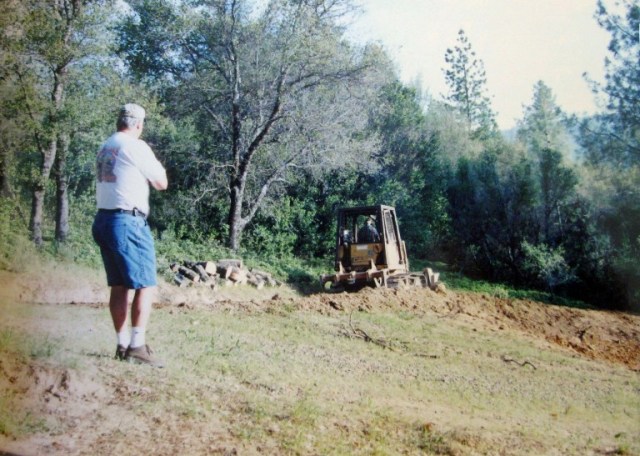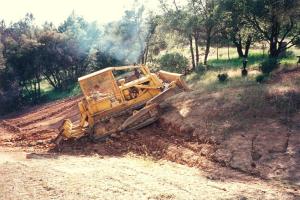I’m only mentioning my impressions of the house pad prep, because to tell it all would be very boring. Although,….we country folk can talk for hours amongst ourselves about the details of our septic installations and well digging. Those subjects, especially the depth and gallons per minute for your well are hot topics among the flannel shirted neighbors here!
***
Have I mentioned that we’re from the suburbs? Preparing the pad where our new house would sit was a challenge the like we’d never had before. Our land was sloped 15 degrees. there were trees in the way. There were no utilities in place. We had deer and birds and trees and grass and a fantastic view, that’s all. When we asked our friends if we could do this, we really were asking will you help us with advice and labor and …., well, friendship. They did help,…and went way beyond that.
This was our To Do List:
Bulldoze a flat area big enough for the house to fit
Build a retaining wall to hold back the earth from the pad
Reroute the hairpin shaped driveway
Install a septic system
Dig a well
Install electricity and phone lines underground
Obtain a building permit
The extra twist was that the house building company could raise prices all during this period until we submitted the permit. This whole process took a year.
You need bulldozers
One thing we needed right away as a flat place to park, camp and live during the first few years after we bought the place. This need led to a wonderful weekend before Mother’s Day when we had the bulldozer guy come in a dig, scrape or bulldoze a pad. We had no idea how to do the first job,…constructing the house pad, and I remember well the conversation we had with the bulldozer man. He asked how we wanted it ….we said “ahh…..”, he said “well, you probably want it done ‘cut and fill’ with a ‘winterized’ edge” and we said, “Oh, that sounds good!”
This meant that since we are on a 15% grade, he’d cut dirt from the hillside and push it out towards the slope and the edge would have a wide lip so as not to erode.
You need strong backs
We needed to build a retaining wall so the house could snug into the hill. There would only be room for a driveway between the hill and the house like many homes in this mountainous area.
We followed the contour of the hill for a natural look and it was easy at first, back breaking after a few hours and since we had to finish in a single weekend we felt like we were working on a chain gang by Sunday afternoon.
Later I planted rosemary and lavender on the top edge of this wall, which proved themselves hardy enough to survive with monthly water hauled down from the neighbor’s faucet each time we visited.

A trencher dug for two long drain pipes to prevent the 'pond' from flooding and provide a flat parking area.
You can see where we set up ‘camp’ between the goat shed and the house pad. Now this area is kept clear for visitors to park in and has a small wood shed area.
You need backhoes
Hmmmm, Tractor Man is down in a trench 10 ft deep, walking around. Hmmmm. The highlight for me while our septic system was dug was rescuing the huge rocks unearthed by the back hoe. I became a pretty good heavy equipment dodger and soon I had a large collection rocks to play with in the garden.
What amazed me was that there are no moving parts in a septic tank. I was also amazed when told that 40% of Americans use private septic systems. And that there was 50 tons of rock on our driveway. And that we took NO photos of this process. I was amazed to find my husband on the phone ordering a huge crane from Fresno. The huge 1500 gallon cement tank couldn’t be off loaded because the distance was 16 feet over the edge not 8 feet.
You need divining rods
We ‘divined’ for water months before the well diggers came. The neighbor retrieved the divining rods from where they hang in another neighbor’s peach tree. They are two welding rods about 20 inches long with 90 degree bends at the ends. First she walked around in the general area where we wanted the well and declared that yes, it seemed like water was there! Then I tried. I held the rods loosely in my hands, not believing one bit, and they still moved when I didn’t mean them to.

We called again for bulldozers and had a place made for the well, pump and we also rerouted the driveway
What amazed me was that when the well digger came, he said, “Now if you divined for water,…don’t tell me where you think it may be.” He used his own rods and ‘found’ water where the neighbor had, up on the hill where there was a wide gulley a hundred feet above the house pad. I don’t believe it still. But that’s how it went. Fortunately we wanted the well and 2600 gallon water storage tank up the hill from the house in this very spot so there would be gravity feed water if there was a power outage.
You need friends
We coordinated our electrical lines to be placed underground along with the phone lines. They needed to also be run to the well and back to the house, which by the way, was only framed and sided by August 2005. No windows, drywall, paint or plumbing was completed yet.
We had sold our house in June and had a 2 week business trip to South Dakota coming up. Our good friends stepped up and in the heat of August when the ground is like cement, put in all our electricity from the top of the driveway down to the well and then to the house. We returned to hold the biggest BBQ ever to thank them!

2000-10 House pad-before....this is what we started with...oaks, pines and manzanita. The middle trees here are where the house stands now.

Poof, fast forward a year and you can clearly see the beauty of the location here. This is in summer of 2005 with the house framed and painted outside.
Here in the mountain community around Oakhurst, you learn to depend on your neighbors and always be thinking of how you can be of help during times of trouble and during big ‘barn-raising type’ projects.













Pingback: Choosing a home builder in the Sierra Foothills | Sierra Foothill Garden